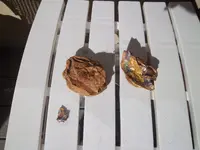RTR - you got me on that one!
So you use old cheap detectors, they can be made to be very, very good. The White's 6000D and similar units can be super tuned by using very small amounts of 'metal dust' (held in a penny balloon or some other holder so the dust is all in one tight spot). With these test samples (dust of: cast iron, refined steel, from a silver dime, from a nickel (this will suffice as gold but if you have some old gold you can file down then do that as well), from a penny, from ammunition brass, etc. AS these are all common metals you will come across out there and you want to learn how your detector reacts to them. With all the filtering knobs turned to zero or off begin testing your samples to hear how they sound: high, low, warbly, broken, etc. and write all of these results down. then begin to start using your filters to learn where these metals break up or blank out and mark your filter settings. Somewhere in the foil area you will blank out the metal Nickel and hence gold. The outcome of all this testing and identifying on the detector with little triangles of colored tape will allow you to detect with all filters at zero, once you hit a target your flip a switch or turn a knob, wave the coil over the ground for the result, flip another switch and turn a knob, wave the coil and you will know what metal is under your coil. Work with this as it is valuable to super-tune your machine..................63bkpkr







